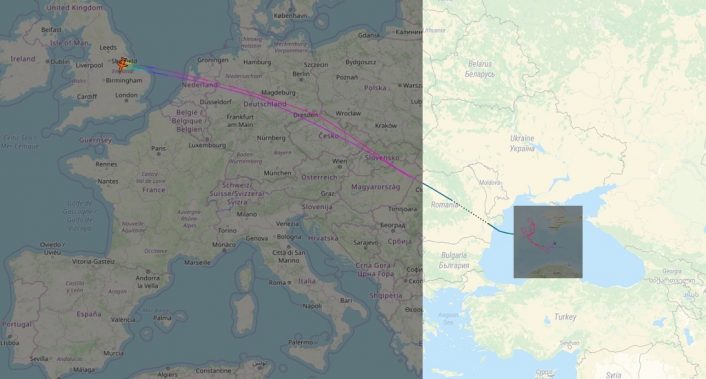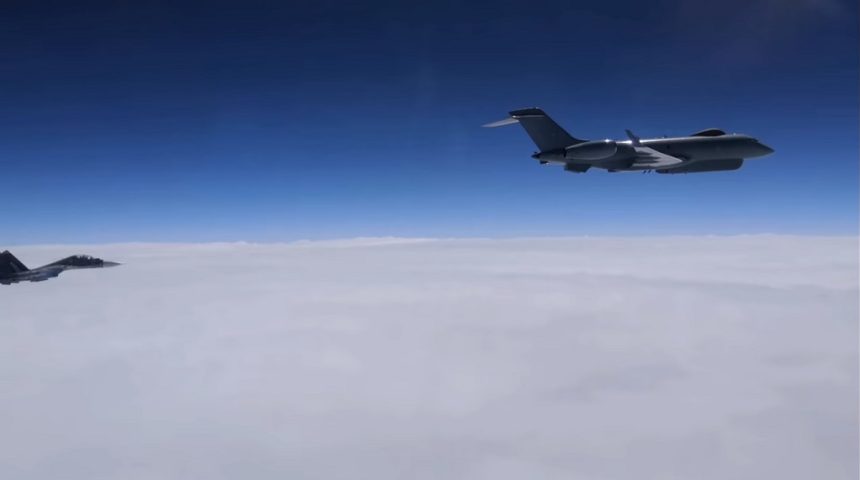A video emerged showing the Flankers keeping a safe distance from the ISR aircraft
A short video surfaced online on May 29, 2020 showing a Royal Air Force Sentinel R1 intercepted by two Russian Su-30SM over the Black Sea. According to the video description, the two Flankers belong to the Black Sea Fleet Naval Aviation and were scrambled to intercept the Sentinel at the same time two Su-27s were intercepting a U.S. B-1B bomber involved in a Bomber Task Force mission in the same area, which we already reported a few days ago.
Like happened during the B-1B interception, the Flankers escorted the Sentinel while keeping a safe distance. This close encounter has not been acknowledged officially by the United Kingdom or Russia, even if the latter stated that Su-30s were scrambled together with the Su-27s that intercepted the “Bone” but were not visible in the video that was released: “Su-27P and Su-30SM fighters from the air defense alert quick reaction forces of the Southern Military District were scrambled to intercept the targets.”
However, thanks to ADS-B flight tracking, we verified that indeed a Sentinel R1 was flying a surveillance mission over the Black Sea near Crimea in the morning of May 29. By using different sources, we identified the ISR aircraft and reconstructed the route that was flown.

The aircraft seems to be the Sentinel R1 ZJ691 flying with callsign RRR7305, which departed RAF Waddington at around 01:45 A.M. UTC and reached the Black Sea at about 5 A.M. UTC to start a three-hour patrol. As can be seen in the image tweeted by open source aircraft tracker Manu Gómez, a U.S. Navy P-8 Poseidon was operating at the same time in the area.
#BlackSea/#Crimea
RAF Global Express Sentinel R.1 ZJ691
US Navy P8 Poseidon AE6872 pic.twitter.com/RRb5MtA2XV
— Manu Gómez (@GDarkconrad) May 29, 2020
Just a week before this episode, the British Ministry of Defence was asked about the service life of the Sentinel and the Jeremy Quin, Minister of State at the M.o.D., confirmed that the aircraft will be retired in March 2021 due to “increasing obsolescence” after important upgrades were cancelled by the 2010 Defence Review, leaving the U.K. without a long-range, wide-area battlefield surveillance capability as a replacement has not been yet determined. Here is an extract of the official statement:
“Sentinel was introduced in 2008 in the knowledge that a significant equipment upgrade would be required in the mid 2010’s.
The Defence Review in 2010 cancelled this expected upgrade bringing forward the likely out of service date.
The SDSR 2015 determined that Sentinel should be retained for a further period and set a new out of service date of March 2021. While some work was conducted on the on-board equipment this fell well short of a full system upgrade.
The radar and mission system are now increasingly obsolescent and will face increasing reliability issues as time progresses.
Retaining the capability would have required significant upgrade expenditure and the March 2021 out of service date has been retained.
No identical capability is operated by the UK (though similar capabilities exist in the NATO inventory).”
H/T to Alex Snow for sending this over to us.









